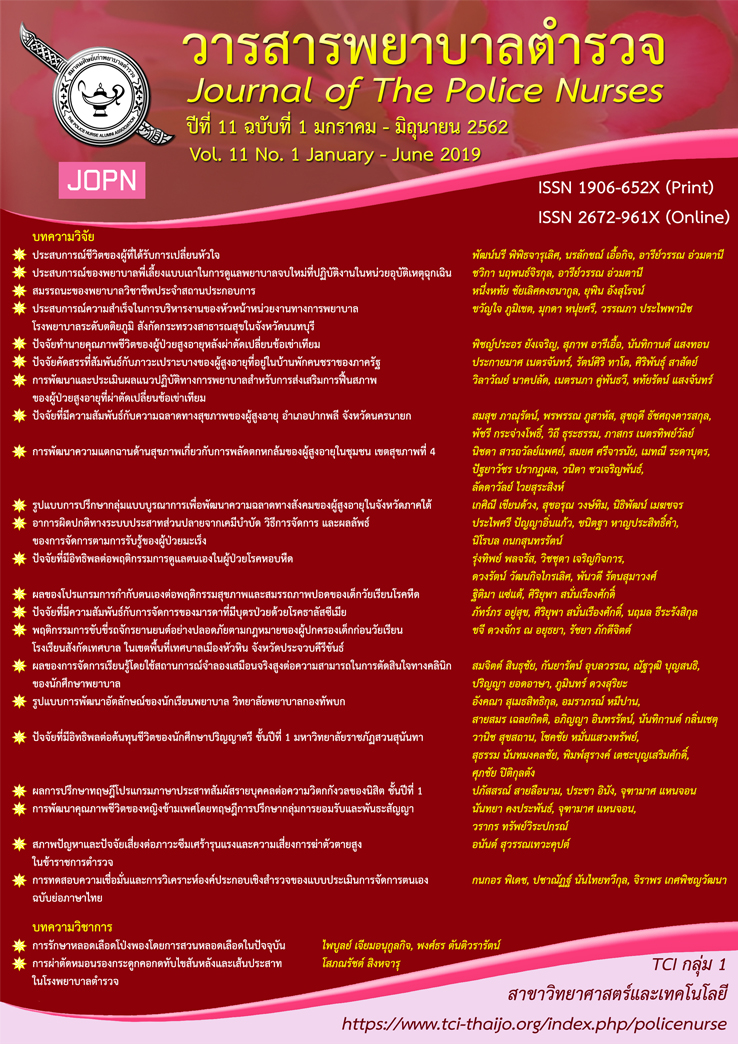CHEMOTHERAPY INDUCED PERIPHERAL NEUROPATHY, MANAGEMENTS STRATEGIES, AND OUTCOMES AS PERCIEVED BY CANCER PATIENTS
Keywords:
chemotherapy induced peripheral neuropathy, symptom management strategies, outcomes of symptom management in cancer patients, chemotherapyAbstract
The purposes of this descriptive study were to identify chemotherapy induced peripheral neuropathy, management strategies, and outcomes as perceived by cancer patients based on the symptom management model of Dodd et al. The study sample consisted of 165 cancer patients receiving chemotherapy induced peripheral neuropathy. Data were collected by means of three instruments: 1) the personal data form, 2) the symptom experience of chemotherapy induced peripheral neuropathy questionnaire, and 3) the symptom management strategies and outcomes questionnaire. Data were analyzed using descriptive statistics.
The results revealed that the most occurring chemotherapy induced peripheral neuropathy symptoms of sensory neuropathy including numbness, muscle pain, joint pain, and burning sensation (93.3%, 83.0%, 56.4%, and 15.2%, respectively). The most common symptoms of motor neuropathy consisted of muscle weakness, muscle cramp or tetany, difficulty of breathing, dysphagia, and difficult of chewing (46.7%, 27.3%, 13.3%, 6.7%, and 4.2%, respectively). The symptoms of autonomic neuropathy, the most occurring, were constipation, followed by postural hypotension, and dysuria or urinary incontinence (61.2%, 41.2%, and 8.5%, respectively). Sample perceived both of symptom severity and symptom interference with activities of daily living in the moderate level. The most frequently strategies to manage chemotherapy induced peripheral neuropathy symptoms were relaxed, followed by pharmacological therapy, modified behaviors, exercise/massage, and complementary therapy: herb/ nutrition supplement (87.3%, 82.4%, 74.5%, 69.1%, and 58.2%, respectively). The most effective strategies to reduce chemotherapy induced peripheral neuropathy symptoms were pharmacological therapy, followed by complementary therapy: herb/nutrition supplement.
Results from this study showed that chemotherapy induced peripheral neuropathy affected the patients’ daily activities. Therefore, nurses should be aware and assess patients’ peripheral neuropathy symptoms related to chemotherapy for planning and enabling patients to appropriately and effectively manage their symptoms.
Downloads
References
Blum, L. J. (2005). Clinical implications of using nab paclitaxel in metastatic breast cancer.
Retrived from https://www.oncologypractice. com/co/journal/articles/0203214.pdf
Boonlom, T., Siripitayakunkit, A., kanogsunthornrat, N. (2015). Symptom experiences, symptom
management, and outcomes of persons with diabetes with lower extremity neuropathy. Journal of Nursing and Health Care, 33(3), 16-25.
Chancharean, K. (2005). Population and sample estimation. In P. Jirothkul (Ed.), Nursing Research: Concept, Principle and Practice. (p.85-114). Bangkok: Sangsue.
Dodd, M. J., Janson, S., Facione, N, Faucett, J., Frolicher, E. S., Humphreys, J., ... Taylor, D. (2001). Advancing the science of symptom management. Journal of Advanced Nursing, 33(5), 668 - 676.
Donovan, D. (2009). Management of peripheral neuropathy caused by microtubule inhibitors. Clinical Journal of Oncology Nursing, 13(6), 686-694.
Driessen, C. M. L., de Kleine-Bolt, K. M. E., Vingerhoets, A. J. J. M., Mols, F., & Vreugdenhil, G. (2012). Assessing the impact of chemotherapy-induced peripheral neurotoxicity on the quality of life of cancer patients. Support Care Cancer, 20(4), 877-881.
Garsed, K., Chernova, J., Hastings, M., Lam, C., Marciani, L., & Singh, G. (2013). A randomised trial of ondansetron for the treatment of irritable bowel syndrome with diarrhea. Gut, 63(10),1617-1625.
Gupta, A., & Jakobsson, J. (2014). Acetaminophen, nonsteroidal anti-inflammatory drugs, and cyclooxygenase-2 selective inhibitors: An update. Plastic and Reconstructive Surgery, 134(4), 24s-31s.
Gyneco-oncology Division, Chiang Mai University. (2009). Annual report 2009 gyneco-oncology division. Faculty of Medicine, Chiang Mai University.
Hubjareon, S., & Weerakul, R. (2001). The effects of hot compress with electric blankets on the peripheral neuralgia of colorectal cancer patients receiving oxaliplatin. Thai Cancer Journal, 32(2), 41-53.
Isaacs, B., & Akhtar, A. J. (1972). The set test: A rapid test of mental functional in old people. Age and Aging, 1(4), 222-226.
Katsumata, K. (2011). Dose-dense therapy is of benefit in primary treatment of ovarian cancer? Annals of Oncology, 22(8), 29-32.
Ladawan, A., Petpichetchian, W., & Wiroonpanitch, W. (2005). A survey of common symptoms of cancer patients in southern Thailand. Songkhlanagarind Medical Journal, 23(2), 285-298
Maestri, A., de Pasquale Ceratti, A., Cundari, S., Zanna, C., Cortesi, E., & Crino, L. (2005). A pilot study on the effect of acetyl-L-carnitine in paclitaxel-and cisplatin-induced peripheral neuropathy. Tumori, 91(2), 135-138.
Malangpoothong, R., Pongthavornkamol, K., Sriyuktasuth, A., & Soparattanapaisarn, N. (2009). Symptom experiences, management strategies and functional status in advanced lung cancer patients receiving chemotherapy. Journal of Nursing Science, 27(2), 69-78.
Natason, A., & Limumnoilap, S. (2009). Symptoms and Symptoms managements in cancer patient undergoing chemotherapy. Journal of Nursing and Health Care, 32(1), 12-24.
Pachman, D. R., Barton, D. L., Watson, J. C., & Loprinzi, C. L. (2011). Chemotherapy-induced peripheral neuropathy: Prevention and treatment. Clinical Pharmacology Therapy, 90(3), 377-387.
Park, J. H. (2014). Chemotherapy induced peripheral neuropathic pain. Korean Journal Anesthesiology, 67(1), 4–7.
Petpichetchian, W. (2001). Best nursing practice in cancer care. Songkhla: Chanmuang Publishing.
Quasthoff, S., & Hartung, H. P. (2002). Chemotherapy-induced peripheral neuropathy. Journal of Neurology, 249(1), 9-17.
Samimi, M. A., Zargarzadeh, A. H., Khadiby, N., Mokarian, F., Basi, A., & Abdolahi, M. (2008). Paclitaxel-induced peripheral neuropathy using NCI-CTC in Isfahan, Iran. Iranian Journal of Pharmaceutical Sciences Summe, 4(3), 189-192.
Sasane, M., Tencer, T., French, A., Maro, T., & Beusterien, K. M. (2010). Patient-reported outcomes in chemotherapy-induced peripheral neuropathy: A review. Journal Supportive Oncology, 8(6), E15-E21.
Sudsrong, R., & Singniyom, V. (2002). Neurophysiology (4th ed.). Bangkok: Text and Journal Publication.
Tofthagen, C. (2010). Patient perceptions associated with chemotherapy-induced peripheral neuropathy. Clinical Journal of Oncology Nursing, 14(3), E22-28.
Tofthagen, C., McAllister, R. D., & Visovsky, C. (2013). Peripheral neuropathy caused by paclitaxel and docetaxel: An evaluation and comparison of symptoms. Journal of the Advanced Practitioner Oncology, 4(4), 204-215.
Vasey, P., Atkinson, R., Coleman, R., Crawford, M., Cruickshank, M., Eggleton, P., ... Reed, N. S. (2001). Docetaxel-carboplatin as first line chemotherapy for epithelial ovarian cancer. British Journal of Cancer, 84(2), 170-178.
Visovsky, C., Collins, M., Abbott, L., Aschenbrenner, J., & Hart, C. (2007). Putting evidence into practice: Evidence-based interventions for chemotherapy-induced peripheral neuropathy. Clinical Journal of Oncology Nursing, 11(6), 901-913.
Weerakul, R., & Hubjareon, S. (2001). Effects of a planned teaching program on knowledge and self-care behaviors among lung cancer patients undergoing chemotherapy at Songkhlanagarind Hospital. Thai Cancer Journal, 31(1), 25-33.
Wickham, R. (2007). Chemotherapy-Induced Peripheral Neuropathy: A review and implications for oncology nursing practice. Clinical Journal of Oncology Nursing, 11(3), 361-376.
Wilkes, G. (2007). Peripheral neuropathy related to chemotherapy. Saminars in Oncology Nursing, 23(3), 162-173.
Windebank, A. J., & Grisold, W. (2008). Chemotherapy-induced neuropathy. Journal of the Peripheral Nervous System, 13(1), 27-46.
Winkelman, M. (2004). Spirituality and the healing of addictions: A shamanic drumming approach. In L. L. Barnes, & S. S. Sered (Eds.), Religion and healing in America (pp.455-470) New York, NY: Oxford University Press.
Wolf, S. L., Barton, L. D., Qin, R., Wos, J. E., Sloan, A. J., Liu, H., ... Loprinzi, C. L. (2012). The relationship between numbness, tingling, and shooting/burning pain in patients with chemotherapy-induced peripheral neuropathy (CIPN) as measured by the EORTC QLQ-CIPN20 instrument, N06CA. Support Care Cancer, 20(3), 623- 632.
Downloads
Published
How to Cite
Issue
Section
License
ผลงานที่ได้ตีพิมพ์แล้วจะเป็นลิขสิทธิ์ของวารสารพยาบาลตำรวจ














